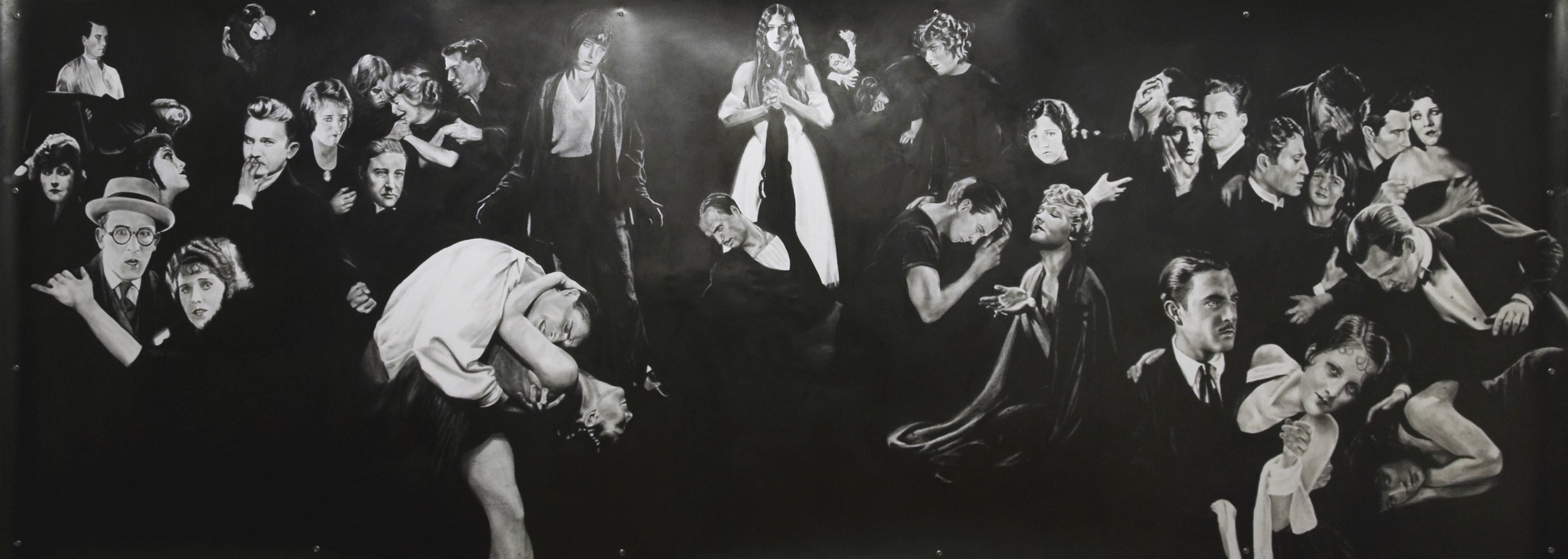Valentino’s Funeral
Anisha Birk
Art Historian and Curator
Featured in Measuring Elvis, 2015
Valentino’s Funeral (2009) wraps across three walls and surrounds a central sculpture. The first part consists of a panorama of large pencil and graphite drawings hung with eyelets. The drawings are representations of Hollywood notables who allegedly attended the funeral of matinee idol Rudolph Valentino [1]. Based largely on found images from cinematic stills, the figures assume various fantasy poses and expressions transposed and assembled by Fowler, themselves often clichés of romantic Hollywood style. The work’s sculptural centre is occupied by a black lacquered open casket, constructed from wood and polymer clay [2].
Many elements of Nina Mae Fowler’s expressive mode, her distinctive visual language, are found gathered together here. The figures — ghostly, poised and impressive — move against a deep black surface. Fowler signals the ‘found’ nature of the images by using an already established language of visual rhetoric: her characters contort, embrace and arabesque in a manner that assumes much of the substance of early motion picture and bespeaks the form of classical ballet. They are organised in a poetic manner, creating an impression of flux that allows the viewer to freely associate from one figure, or group of figures, to the next. This belies the fact that the artist, who, like a skilled theatrical director, has arranged them to gesture at the importance of the moment for each individual.
Arranged into three, the drawings surround a central laquered casket like the fragments of an altarpiece. The spatial relationship between drawing and sculpture force the viewer to experience the work in both time and space, ultimately making choices about where to stand and how to view the artwork. Approaching the casket and circling round to look up at the rest of the piece, one undergoes the sensation of the flat surface gaining in depth, demarcating a sacred space around the casket. The circle is, in effect, a procession to witness and pay respect to the deceased. It transforms the overblown marvel of Valentino’s funeral from a vulgarity of the past into a living spectacle, with viewers once again filing past to gawk at the open casket.
Instead of using drawing as a preparatory form, Fowler employs it to turn time, skill and attention towards aspects of the piece’s experience. The labour demanded in such a dense, meticulous and large-scale work invites intimacy by begging for close analysis. As we inspect the details, we look more attentively and slowly at the work. The immediacy of the drawing, the very extremity of monochrome, contributes to a work of elemental vocabulary, constructing an opposition between the poverty of Fowler’s materials and the glamour that they embrace. The stars depicted in Valentino’s Funeral, most of all Valentino himself, were relentlessly pursued, glorified, interviewed and photographed in their time. Fowler signals their iconic fame by means of emphasised faces against a black backdrop, reminiscent of early forms of portrait photography found in the work of figures like Nadar and Cecil Beaton. Yet in her refusal to commit herself to the world of colours, Fowler does not simply conjure up a retro nostalgia for monochrome photography or silent film. The restraint, instead, acts as a distancing device, establishing a space between her work and the present realities of celebrity culture, high-definition photography and synthetic, mass-produced colours. In doing so, she allows us to contemplate the notion of celebrity and the power of the impulse to admire and worship particular individuals. The logic of the work rests on an assumption that the viewer will question the absurdity of this impulse.
Thought and knowledge are essential components of the work. The creative process required intense research into the historical details of Valentino’s funeral in preparation for the work, Fowler documented a visit to the church of Valentino’s second funeral in Hollywood. In contemplating her painstaking and protracted process, the viewer steps into the artist’s place, encouraged to consider whether Fowler herself is a devotee of Valentino, and how the work perpetuates the memory of a man who was once so famed. The faces of the mourners, the way they suppurate and weep, suggests something grotesquely theatrical. They may cry and mourn, but they conceal as much as they express. We are encouraged to partake in the spectacle and join the mourners. In this sense, there is little to distinguish between the historical event of Valentino’s funeral and Fowler’s parodied version: there is no contrast between the real and the representational.
FOOTNOTES
[1] When Valentino prematurely died on 23 August 1926 of complications from a perforated ulcer, the passing of one of the first international film stars provoked a hysteria of public grief and mourning.
[2] Fowler notes the inspiration for the black lacquered casket came from Kenneth Anger’s book Hollywood Babylon. Anger recounts a story that Rudolph Valentino gave actor Ramon Novarro a black, lacquered art-deco dildo as a gift. This was later found stuffed in Novarro’s throat at the time of his murder. No such gift existed.
